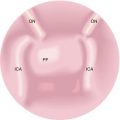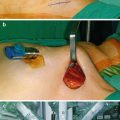Medullary thyroid cancer (100 %)
Pheochromocytoma (50 %)
Multiple neuroma of lip, tongue, and buccal mucosa (>90 %)
Prominent corneal nerve fibers
Ganglioneuromatosis of the GI tract (producing constipation)
Marfanoid habitus
Dry eyes
Foot abnormalities
Hyperflexible joints
Diagnosis and Investigations
FNA of a thyroid or lymph node mass will typically identify oval- or spindle-shaped cells with pleomorphic nuclei and eosinophilic cytoplasm. Immunohistochemistry will be positive for calcitonin and CEA. Core biopsy may in addition reveal malignant cells with a low mitotic rate and amyloid.
An elevated serum calcitonin confirms the diagnosis of MTC and should be measured in all patients prior to surgery as it is a good marker of disease extent (as is CEA). Distant metastasis can be found in patients with calcitonin of as low as 150–400 pg/mL. When there is uncertainty about the histological diagnosis or potential for false-positive calcitonin levels (autoimmune thyroid disease, hypercalcemia, foregut-derived neuroendocrine tumors, and renal failure), a pentagastrin/calcium stimulation test can be performed. Peak values of calcitonin occur at 1–2 min after intravenous pentagastrin/calcium injection.
Pheochromocytoma must be excluded in all patients on diagnosis of MTC by the measurement of urine metanephrines, normetanephrines, and fractionated catecholamine levels in a 24-h urine collection and/or by measurement of plasma normetanephrine/metanephrine levels which have high sensitivity for the detection of pheochromocytoma.
Serum calcium and if elevated PTH levels should be measured before operation because if elevated indicates hyperparathyroidism and the presence of familial disease.
All patients with MTC should be offered RET mutation analysis to identify those patients with genetically determined disease – even in patients with apparently sporadic disease, the prevalence of a germline RET mutation is more than 7 %.
Ultrasound scan of the neck can identify unsuspected multiple/bilateral thyroid nodules that give a clue that there is familial disease and assess lymph nodes for the presence of metastatic disease. CT or MRI of the neck and mediastinum will in some patients identify unsuspected extrathyroidal spread and lymph node metastases below the brachiocephalic vein inaccessible at neck surgery. The absence of metastatic foci on cross-sectional imaging of the liver and lungs does not exclude the presence of miliary tumor foci below the limit of scan resolution.
Laryngoscopy is indicated in all patients prior to surgery.
Surgery
The aim of neck surgery in patients with MTC is to obtain local control and provide the optimum chance of clinical and biochemical cure. Total thyroidectomy and central compartment lymph node dissection are the minimum interventions that should be performed when the diagnosis is made prior to surgery. If the diagnosis is made after thyroid lobectomy or total thyroidectomy, because lymph node metastases in level 6 occur so frequently (up to 80 % of patients), completion central compartment node dissection is mandated. The frequency of lateral compartment node metastases is high – ipsilateral 30–80 % and contralateral 19–50 % – so in patients without evidence of distant metastases, ipsilateral lateral compartment selective neck dissection (levels 2–5) should be also be performed. In patients with 2 or more lymph node compartments positive for metastases, cure is not achieved, so in the absence of radiological/palpable nodal disease in the contralateral lateral compartment, it is not unreasonable to delay further lateral neck until required on the basis of evident disease.
Tips for Surgery
If you get it right the first time, you will reduce the need for reoperation in the central neck.
Aim to preserve recurrent/superior laryngeal nerves and parathyroid glands.
In patients with elevated basal calcitonin and or lymph node metastases, perform total thyroidectomy and central / and at least, ipsilaterallateral compartment selective neck dissection.
In patients with infra-brachiocephalic lymph node involvement (or high risk on the basis of a T4 tumor), transsternal mediastinal node dissection should be performed or considered to minimize the risk of future airway/esophageal/recurrent laryngeal nerve compromise.
In patients who present with distant metastases, survival may be prolonged. On that basis, total thyroidectomy and central compartment node dissection should be considered and, if required, resection of symptomatic disease in the lateral neck or mediastinum.
Stay updated, free articles. Join our Telegram channel

Full access? Get Clinical Tree





